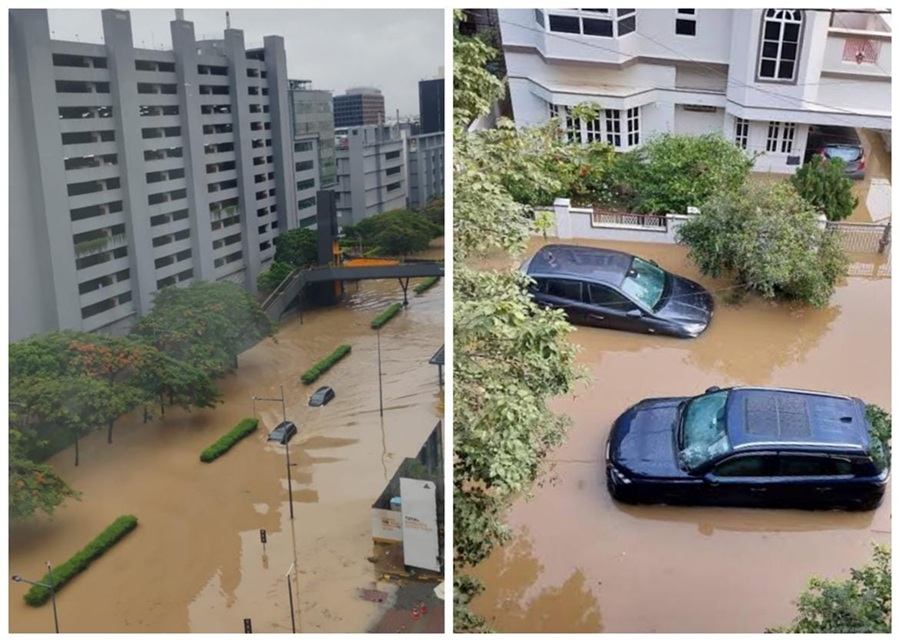In mid-May 2025, Bengaluru was hit by its heaviest rainfall in over a decade, with some areas recording upwards of 270 mm over just 36 hours. Low-lying neighbourhoods, busy IT corridors and even iconic landmarks like the Kanteerava Stadium were inundated, leading to at least five confirmed deaths, widespread power outages and transportation paralysis. The deluge laid bare chronic shortcomings in storm-water drainage, urban planning and lake conservation—issues long warned by experts. While local authorities have deployed rescue teams and issued traffic advisories, critics say relief is ad hoc and call for systemic reforms that integrate climate resilience into the city’s growth.
Overview of the Deluge
Bengaluru experienced an extraordinary downpour between May 19 and 20, 2025, with consecutive IMD alerts. Several areas saw more than 130 mm in just 12 hours, the highest since 2017. In parts of South Bengaluru, Rajarajeshwari Nagar recorded 132 mm, while North Bengaluru’s Vaderahalli saw 131.5 mm of rain. Overall totals approached 270 mm in 36 hours—making this May the wettest on record for the city.
This exceptional rainfall stemmed from the convergence of two low-pressure systems over the Bay of Bengal and intense thunderstorms forecast by the IMD. An orange alert was in place for heavy showers, with warnings of up to 10 cm of rain on successive days.
Impact on Infrastructure and Daily Life
Housing, Power and Property Damage
Rapid inundation caused by overwhelmed drains led to water entering ground floors and subways. In Sai Layout, hundreds of homes were submerged, forcing families to wade through knee-deep water and salvage belongings. Several compound walls collapsed under soil erosion; at one IT firm’s campus, the wall gave way, tragically killing a 35-year-old employee.
Electricity supply was disrupted across low-lying sectors, leaving residents without power and communications for hours. In many localities, transformers tripped as floodwaters rose, compounding the difficulty of rescue operations.
Traffic Gridlock and Public Transport Halt
Major arterial roads became impassable. Flood-waters on Sarjapur Road and numerous underpasses forced authorities to close flyovers and re-route traffic, leading to miles-long jams. BMTC buses were suspended in several zones, stranding commuters and prompting tech companies to ask employees to work from home.
Private vehicles fared little better. A viral social-media image showed a car with ankle-deep water in its cabin, prompting tongue-in-cheek comments that one now needs a life jacket instead of a seatbelt.
Government and Community Response
Official Measures and Rescue Operations
The Bruhat Bengaluru Mahanagara Palike (BBMP) deployed JCB machines and municipal teams to clear clogged storm-water drains and pump out excess water. An MLA was famously spotted riding a JCB to assess damage in the worst-hit zones, underscoring the crisis’ scale. State Disaster Response Force units used inflatable boats to evacuate stranded families, and relief camps were set up in community halls.
Deputy Chief Minister DK Shivakumar toured flooded areas, assuring citizens that “70 percent of flooding has been resolved” while promising further resources for repair work. However, critics on social media and opposition leaders argue relief has been reactive rather than proactive.
Community Initiatives
Local resident groups mobilized volunteers with sandbags and sump pumps to divert water from critical junctions. NGOs and citizen-journalists used live maps on social platforms to update motorists on flooded stretches. Social media fund-raisers raised lakhs of rupees within hours to buy relief kits for the elderly and children in inundated neighbourhoods.
Meteorological Analysis
The IMD has attributed the rains to a combination of cyclonic circulations over the Andaman Sea and a trough extending into the mainland. Pre-monsoon showers are normal in May, but the intensity witnessed was labelled “rare” by the regional weather department director, CS Patil. Satellite imagery showed cloud clusters stalling over the city, dumping sustained heavy rainfall rather than quick bursts.
Climate scientists warn that such erratic, intense rainfall events are likely to increase as India warms. Bengaluru, situated on the Deccan Plateau, historically saw more gradual monsoon patterns; sudden spikes in rainfall heighten flash-flood risks when urban drains can’t cope.
Long-term Implications and Climate Context
Urban Planning and Drainage Systems
Experts point to decades of unchecked construction over former lakes and wetlands—natural buffers that once absorbed monsoon surges. The revival of the ancient Sampangi Lake under Kanteerava Stadium was highlighted when flood-water gushed into the arena, evoking memories of Bengaluru’s lost water heritage. Rapid expansion of concrete surfaces without adequate rainwater harvesting exacerbates run-off.
The BBMP has identified 210 flood-prone zones, but critics say mitigation plans lack teeth and funding. Calls have grown louder for a comprehensive overhaul of the city master plan, mandating green belts, recharge pits, and interlinked lake corridors to serve as retention basins.
Policy and Climate Resilience
The state government has announced a ₹500 crore flood-mitigation fund, to be used over three years for upgrading storm-water drains and desilting lakes. But environmentalists demand independent audits, transparent fund flows and community participation in lake-restoration projects. They argue that piecemeal fixes will fail unless integrated within a holistic climate-resilient urban framework.
For India’s tech-capital, which contributes nearly 38 percent of Karnataka’s tax revenue, ensuring uninterrupted power, transport and data-centre uptime is crucial. Businesses have formed a consortium to lobby for faster implementation of city-wide flood-management systems.
Conclusion
The May 2025 deluge in Bengaluru was both a wake-up call and a symptom of deeper planning failures. While immediate relief efforts mitigated worst hardships, the pattern of pre-monsoon inundations demands long-term structural reforms. From reviving lakes and wetlands to modernizing drainage and enforcing climate-safe building codes, Bengaluru must transform lessons from this catastrophe into resilient action. Otherwise, the next storm may find the city equally—and avoidably—under water.
